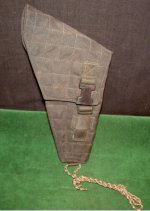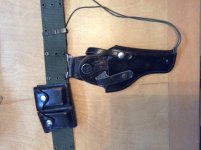I picked up this Eagle flap holster the other day. There are none pictured like it elsewhere on the web that I have found.
I wonder whether any last generation Special Ops guys might have seen one and can tie it to the S&W 66 or 686 revolvers used by those forces.
Eagle (St Louis) made this of multi-layer, quilted cordura. The Nexus buckle date code is mid 1989. The bottom is open, and there are no retention devices other than the flap. Belt hangers are 1956, and a 2" belt loop is sewn between.
The fit is perfect for my model 19 6" with factory magnum grips, although my 625 with full lug barrel will fit in (factory magnum grips barely stick out past the flap)- so any K, L or N frame might have been the design size.
Anyone encountered this holster before? If so, I'd like to know which units contracted for it, or which agencies or commercial outlets handled it. If military, I'll check with the proper museum to determine whether they have an interest. If commercial, I'll use the holster and be proud to have it.

I wonder whether any last generation Special Ops guys might have seen one and can tie it to the S&W 66 or 686 revolvers used by those forces.
Eagle (St Louis) made this of multi-layer, quilted cordura. The Nexus buckle date code is mid 1989. The bottom is open, and there are no retention devices other than the flap. Belt hangers are 1956, and a 2" belt loop is sewn between.
The fit is perfect for my model 19 6" with factory magnum grips, although my 625 with full lug barrel will fit in (factory magnum grips barely stick out past the flap)- so any K, L or N frame might have been the design size.
Anyone encountered this holster before? If so, I'd like to know which units contracted for it, or which agencies or commercial outlets handled it. If military, I'll check with the proper museum to determine whether they have an interest. If commercial, I'll use the holster and be proud to have it.


